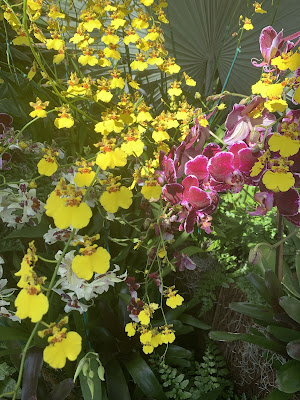Every year the Chicago Botanic Garden hosts an Orchid Show. Dan and I have gone the past three years and have made a little tradition out of it to go usually around the tail end of spring or very late winter. CBG's Green Houses, of which there are a few, are filled with orchids, palm trees, aloe plants such as succulents, and cacti. It always has been a gorgeous exhibition, allowing us a bit of the tropical culture and atmosphere here in Chicago.
An orchid is a very striking flower, possibly one of the most striking looking flowers I've ever seen. Their colors range the spectrum, and their spread looks beautiful, but also almost vicious and violent. The use of these manifestations is to attract as many pollinators as possible, which they also do with their scent. Pollinators, such as bees and butterflies, are important for the spreading of seeds. Without pollinators, orchids - and any plant as a matter of fact - wouldn't be as geographically far reaching as they are today.
There are three main parts to the orchid: two of which are large identically symmetrical petals, and one petal in the middle called a "lip".
Orchids thrive in the tropical atmosphere. What we call "the tropics" is all the land around the globe closest to the equator: the equator is the area of Earth that is the hottest from the Sun. Our maps and globes delineate the tropical environment as the entire equatorial area, marked off by the Tropic of Cancer at the top and the Tropic of Capricorn at the bottom. This place is very humid and very, very warm.
These flowering plants are highly adaptive and have evolved into three forms:
1. Terrestrial
2. Epiphytes
3. Vines
Terrestrial orchids are those orchids which grow on the ground with their roots becoming strong down and in the ground just like other flowers. But as a product of the all the competition for resources: namely space, water, and sunlight, orchids evolved to reach up and grow on taller trees and tall plants. Those orchids which evolved to avoid competition on the ground are called epiphytes. Epiphytic orchids avoide the cramped space down below, however, they needed to adapt further. Because of the heavy sunlight they receive from being higher, epiphytic orchids learned how to absorb water through dew and fog and retain it so as to not dry out. Many terrestrial orchids ended up dying for lack of sunlight and access to rain. Vine orchids, like other vines, wrap their stems along trees and other tall plants in a vine-like fashion - with epiphytic roots around the trunk. Both vines and epiphytes do not receive their nutrients from the trees and the other tall plants that support them. Rather, their nutrients are from dying or decayed matter of all kinds as well as directly from the sun and rain.



As you can see, orchids are gorgeous. In the fight for survival, orchids have become really creative and clever to remain in the game. They mimic the look of other plants, like mushrooms, in order to lure in pollinators, they use colors and even crystals to attract pollinators like flies, they use different scent techniques to draw other insects in. They can either smell like a carcass, or like lily of the valley.
While orchids are not my favorite flower (I like peonies, at least at the moment. And roses) there is much to learn from them about adaptation, survival, and inventive evolutionary technique.
One of my favorite things about going to the Orchid Show is being surrounded by scent and color and such warmth in the green houses. I would live in a green house if I could. There is something ultimately relaxing, refreshing, and soothing about green houses and tropical weather that is not infused with polluted properties.
Thanks for reading!
- F











